For the latest updates, see EPR Release Notices.
For EPR related videos, check out Digital Education's YouTube Channel.
For the latest updates, see EPR Release Notices.
For EPR related videos, check out Digital Education's YouTube Channel.
Allergy/Adverse Reactions
Covered in this topic:
Drug/Latex/Environmental Allergies
Documenting Allergy/Adverse Reaction Assessment
Drug/Latex/Environmental Allergies
Searching a drug/latex/environmental allergen in EPR should be exhaustive before defaulting to a free-text entry. You can perform partial word searches, or search by brand/generic names.
Free-texting a drug/latex/environmental allergen should be avoided and only done as a last resort, as they are not evaluated by EPR for potential interactions and alerts.
Always pick from EPR’s list when possible or search thoroughly for the item.
Free-text allergies will be on the Patient Dashboard with a yellow highlight and asterisk (see below) and you can hover over them for more information.
Note: Free-text symptoms will also have an asterisk, but have no impact on interaction checks or order entry alerts when just a symptom.
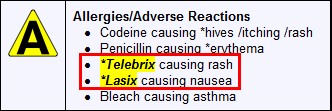
Many food allergies can be selected from the common options list of food allergies.
Free-texting - Allergies that are not found on the common options list should be entered as free text.
If food allergies are updated/changed, the diet order must always be reordered. (In order entry, do not use the change option to update the diet order- start over or use copy button to save time if the diet is complex.)
Searching for food allergens in EPR is prohibited. The allergen must be either selected from the visible list of common options, or they must be free-texted.
DO NOT use the search feature if the food allergen is not on the first list.
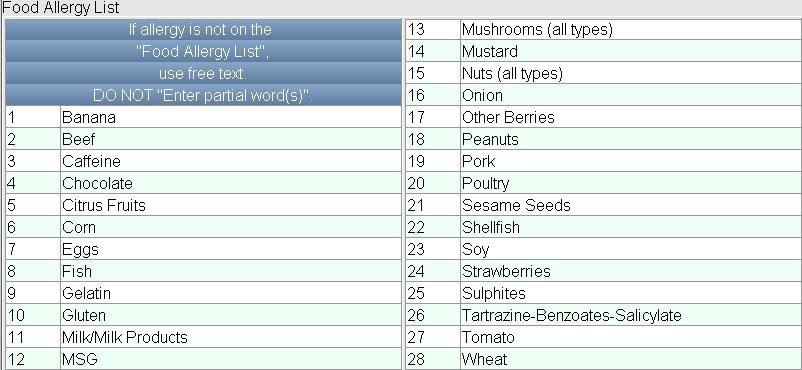
Documenting Allergy/Adverse Reaction Assessment
UHN Policy states that the first clinician to assess the patient should document the allergies/adverse reactions within the first 24 hours of admission or ASAP.
This assessment must be documented before any entry of any orders, including medication, diets, labs and imaging. (If not, an alert will appear each time a medication order is entered stating that no allergies have been documented).
The assessment should be completed in full at the time of entry to avoid partial documentation because attempts to finish a partial documentation via Patient Care Schedule will actually erase all previously entered information and only save the updated fields.
1. From the Patient Desktop, Assessments tab (also found under Patient Care tab, Assessment section depending on EPR user access), click on Allergy/Adverse Reaction. The Allergy/Adverse Reaction assessment is used to document medication, food and environmental allergens.
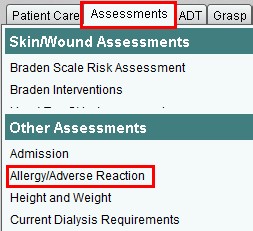
2. Enter the day/time of the assessment or accept the default time of now and click OK.
3. Choose option to document the Source from whom the information was obtained.
Note: Each time you come in to this section to either update or enter in a new assessment, you will be mandated to address this field.
4. Complete the three allergy fields as discovered in your assessment. Even if the patient has no allergies/adverse reactions, you still need to document each by choosing the option No Known x Allergy/Adverse Reaction.
· Medication Allergies
· Food Allergies
· Other/Latex Allergies
Critical: the allergens must be documented under the correct type of allergen i.e. Medication, Food or Other/ Latex.
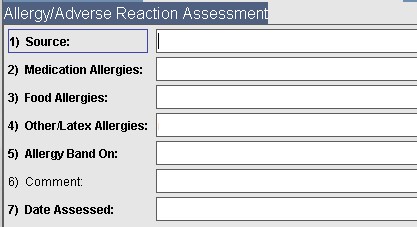
a. Select the allergen. If the allergen is not on the initial list:
DRUG/LATEX/ENVIRONMENTAL: search for the allergen. Place a dash (-) to search by partial words (ie. las- to find Lasix). Try brand names and generic names in your searching.
FOOD allergies: enter free-text. DO NOT search.
b. Select the most severe symptom.
c. If there are multiple symptoms, you would enter in the most severe in the first field with the additional ones in the Addt’nl Symptom field.)
d. Verified Time will auto-fill if it is a new allergen. If you are updating details of an existing allergen, you will need to manually update the Verified Time field here to whenever the new information was received.
e. Make any additional notes about the allergen using the last field
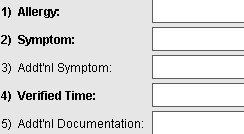
5. Choose option Yes or No to document if the allergy band is updated and on.
Note: Each time you come in to this section to either update or enter in a new assessment, you will be mandated to address this field.
6. Make any additional notes about the assessment occurrence using the Comment field, as needed.
7. Date Assessed will auto-fill if you came in from the Assessments tab to document correctly. Therefore, this field should not need to manually updated.
Note: If you need to update information in an existing assessment, you should do a whole new assessment.
8. Click OK and choose Accept to save your work.
Note: If you are not the first clinician assessing the patient and/or documenting the allergies, it is important you review the allergy documentation by clicking on the Patient Cautions icon and click Viewed on the Patient Cautions Summary dialogue box to help remind you that you have reviewed the most updated. Every time the allergy assessment has been updated, the Check Mark will revert to an exclamation mark as a prompt to remind you to review the updated information.

See Correct, Supplement or Cancel Assessment Documentation or Reviewing Assessment Documentation topics for steps on handling existing assessments.